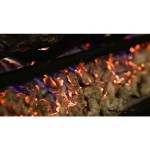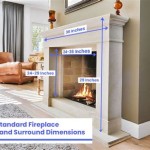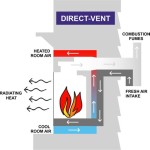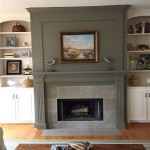Faux River Rock Fireplace: Aesthetics and Practicality
Faux river rock fireplaces have become increasingly popular as a cost-effective and aesthetically pleasing alternative to traditional stone fireplaces. They offer the visual appeal of natural river rock without the weight, expense, and installation complexities associated with genuine stone. The term 'faux' refers to the artificial construction of the material, designed to mimic the appearance and texture of authentic river rock. This article will explore the various aspects of faux river rock fireplaces, covering their composition, advantages, installation considerations, style variations, and maintenance requirements.
The appeal of a river rock fireplace stems from its ability to bring a sense of natural beauty and rustic charm into a living space. Real river rock, with its smooth, rounded contours and varied colors, evokes a feeling of tranquility and connection to the outdoors. Faux river rock aims to replicate this aesthetic, providing homeowners with a more accessible way to achieve this desired ambiance. The inherent variations in color and texture within river rock create a visually interesting focal point, contributing to a warm and inviting atmosphere in any room.
Composition and Manufacturing of Faux River Rock
Faux river rock is typically manufactured using a combination of materials, most commonly concrete, lightweight aggregate, and various pigments. The specific composition can vary depending on the manufacturer and the desired aesthetic. Concrete provides the structural foundation, while lightweight aggregate, such as expanded shale or polystyrene beads, reduces the overall weight of the material. This is a significant advantage compared to natural stone, which can be extremely heavy and require specialized structural support.
The manufacturing process generally involves creating molds that replicate the shape and texture of real river rock. These molds are often made from actual river rock, capturing the subtle nuances and variations found in nature. Once the molds are prepared, the concrete mixture is poured in and allowed to cure. Pigments are added to the concrete mixture to achieve the desired color variations. These pigments are often carefully selected and blended to mimic the natural color palette of river rock, which can range from grays and browns to reds and yellows.
After the concrete has cured, the faux river rock pieces are removed from the molds and may undergo additional finishing processes to enhance their appearance. This can involve applying sealants to protect the material from moisture and staining, as well as adding surface textures to further replicate the look and feel of real river rock. Some manufacturers also offer faux river rock with integrated coloring, meaning the color is embedded throughout the material, rather than just being applied to the surface. This can improve the durability and longevity of the finish.
A key aspect of faux river rock manufacturing is the careful attention to detail in replicating the natural variations found in real stone. This includes varying the size, shape, and color of individual pieces to create a more authentic look. High-quality faux river rock will exhibit a natural, random pattern that avoids repetition and gives the impression of being individually selected and placed stones.
Advantages of Choosing Faux River Rock
Faux river rock offers several advantages over natural stone, making it an appealing choice for many homeowners. The most significant advantage is cost. Natural river rock can be expensive to source, transport, and install, especially if it needs to be custom-cut or fitted. Faux river rock, on the other hand, is typically more affordable and readily available. This cost-effectiveness makes it a viable option for homeowners on a budget who still want to achieve the look of a river rock fireplace.
Weight is another key advantage. Natural stone is heavy, requiring significant structural support to prevent cracking or instability in the fireplace surround or the floor beneath. Faux river rock, due to its lightweight composition, places less stress on the underlying structure. This can simplify the installation process and reduce the need for costly reinforcements. In some cases, faux river rock can even be installed on walls that would not be able to support the weight of natural stone.
Installation is generally easier and faster with faux river rock. It can be cut with standard power tools, simplifying the process of fitting pieces around corners or other architectural features. Many faux river rock products are designed with interlocking edges, making installation even simpler and more precise. This reduces the amount of time and labor required for installation, further contributing to cost savings.
Versatility is another advantage. Faux river rock can be used in a wider range of applications compared to natural stone. Its lighter weight and ease of installation make it suitable for both interior and exterior applications, including fireplaces, accent walls, and landscaping features. It can also be applied to a variety of surfaces, including drywall, concrete, and wood, providing greater flexibility in design and application.
Finally, faux river rock is often more consistent in color and texture compared to natural stone. While natural variations are desirable, excessive variations can be difficult to work with and may not align with the desired aesthetic. Faux river rock allows for greater control over the final appearance, ensuring a more uniform and predictable result.
Installation Considerations and Techniques
Proper installation is crucial to achieving a visually appealing and durable faux river rock fireplace. The first step is to prepare the surface to which the faux river rock will be applied. This typically involves cleaning the surface to remove any dirt, dust, or debris. If the surface is uneven or damaged, it may need to be repaired or leveled before installation can begin. A scratch coat of mortar may be needed to provide a solid base.
The choice of adhesive is also important. A high-quality construction adhesive or thin-set mortar specifically designed for stone veneer is recommended. The adhesive should be applied to the back of each faux river rock piece, as well as to the surface to which it will be adhered. The amount of adhesive used will depend on the size and weight of the piece.
When installing the faux river rock, it is important to maintain consistent spacing between the pieces. This can be achieved by using spacers or shims. The spacing should be determined based on the desired aesthetic and the size of the individual pieces. A random pattern is generally preferred to achieve a more natural look. Varying the size, shape, and color of the pieces can further enhance the natural appearance.
Cutting the faux river rock may be necessary to fit around corners or other architectural features. This can be done using a wet saw or a masonry saw. It is important to wear appropriate safety gear, such as safety glasses and a dust mask, when cutting the material. After cutting, the edges of the pieces may need to be smoothed or finished to remove any sharp edges or rough spots.
Grouting is an optional step that can enhance the appearance and durability of the faux river rock fireplace. Grout fills the spaces between the pieces, creating a more cohesive and finished look. The choice of grout color will depend on the desired aesthetic. A matching grout color will create a more seamless look, while a contrasting grout color will highlight the individual pieces. Applying a sealant to the grout can help to prevent staining and moisture damage.
Proper ventilation is essential for any fireplace, including those with a faux river rock surround. Ensure that the fireplace has adequate ventilation to prevent the buildup of carbon monoxide and other harmful gases. Consult with building codes and regulations to ensure compliance with all applicable safety standards.
Styling and Design Variations
Faux river rock fireplaces offer a wide range of styling and design options. The size, shape, and color of the faux river rock can be customized to create a unique and personalized look. Different patterns and arrangements can also be used to achieve different aesthetic effects. For example, a stacked pattern can create a more modern and streamlined look, while a random pattern can create a more rustic and natural look.
The color of the faux river rock can also be customized to match the existing décor of the room. Neutral colors, such as grays and browns, are versatile and can complement a wide range of styles. Warmer colors, such as reds and yellows, can add warmth and vibrancy to the room. Consider the existing color palette of the room when selecting the color of the faux river rock to ensure a cohesive and harmonious design.
Faux river rock can be combined with other materials to create a more visually interesting and dynamic design. For example, wood mantels, metal accents, and glass tiles can be incorporated into the fireplace surround to add texture, contrast, and visual interest.
The size and shape of the fireplace itself can also be customized to suit the specific needs and preferences of the homeowner. A large, imposing fireplace can create a dramatic focal point in the room, while a smaller, more understated fireplace can blend seamlessly into the existing décor. Consider the size and layout of the room when determining the appropriate size and shape of the fireplace.
Maintenance and Care
Faux river rock fireplaces are relatively easy to maintain. Regular cleaning is important to remove dust, dirt, and soot. A soft brush or vacuum cleaner can be used to remove loose debris. For more stubborn stains, a mild detergent and water can be used. Avoid using harsh chemicals or abrasive cleaners, as these can damage the surface of the faux river rock.
Sealing the faux river rock can help to protect it from moisture and staining. A sealant specifically designed for stone veneer is recommended. The sealant should be applied according to the manufacturer's instructions. Reapplication may be necessary every few years, depending on the type of sealant used and the level of exposure to moisture and other elements.
Inspect the faux river rock periodically for any signs of damage, such as cracks, chips, or loose pieces. Promptly repair any damage to prevent further deterioration. Small cracks can be filled with a patching compound designed for concrete or stone. Loose pieces can be reattached with construction adhesive or thin-set mortar.
Avoid placing heavy objects or applying excessive pressure to the faux river rock, as this can cause damage. Use a fireplace screen to protect the faux river rock from sparks and embers. Ensure that the fireplace is properly ventilated to prevent the buildup of moisture and other harmful substances. By following these simple maintenance tips, the faux river rock fireplace can maintain its beauty and durability for many years to come.

Designing Luxurious Stone Fireplaces With A Treasure River Rock Selexstone Selex

Real Stone Veneer River Rounds Stonewood S

How To German Smear A Dated River Rock Fireplace Krista Gilbert

River Rock Fireplaces S Décor Five Important Decisions In Designing A Stone Fireplace Designs Veneer

River Rock Fireplaces Google Search Faux Stone Fake Fireplace

River Rock Fireplace Surround Photos Ideas Houzz

Pin By Tülay Bodur On Toprak Rustic Fireplaces River Rock Fireplace Design

Add River Rock To Your List Of Fireplace Design Ideas You Ll Be Glad Did Stone Selexstone Selex

Shoreblend River Rock Stone Veneer Pro Line

River Rock Fireplace Photos Ideas Houzz
Related Posts








